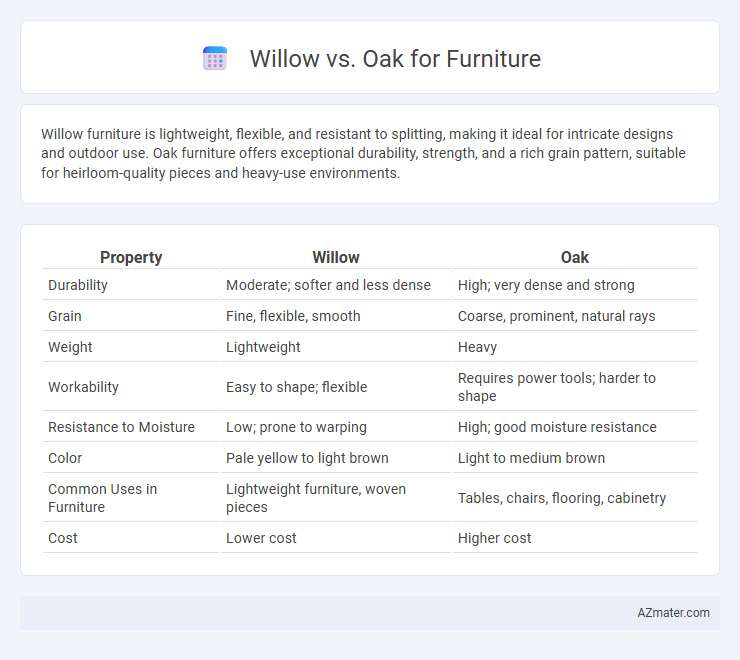Willow furniture is lightweight, flexible, and resistant to splitting, making it ideal for intricate designs and outdoor use. Oak furniture offers exceptional durability, strength, and a rich grain pattern, suitable for heirloom-quality pieces and heavy-use environments.
Table of Comparison
| Property | Willow | Oak |
|---|---|---|
| Durability | Moderate; softer and less dense | High; very dense and strong |
| Grain | Fine, flexible, smooth | Coarse, prominent, natural rays |
| Weight | Lightweight | Heavy |
| Workability | Easy to shape; flexible | Requires power tools; harder to shape |
| Resistance to Moisture | Low; prone to warping | High; good moisture resistance |
| Color | Pale yellow to light brown | Light to medium brown |
| Common Uses in Furniture | Lightweight furniture, woven pieces | Tables, chairs, flooring, cabinetry |
| Cost | Lower cost | Higher cost |
Introduction: Willow vs Oak for Furniture
Willow and oak each offer distinct qualities for furniture craftsmanship, with willow prized for its lightweight flexibility and natural resistance to water, making it ideal for woven and rustic pieces. Oak features a dense, hardwood composition renowned for its strength, durability, and prominent grain, suitable for long-lasting, sturdy furniture designs. Choosing between willow and oak furniture depends on desired aesthetics, functional requirements, and environmental conditions of use.
Wood Characteristics: Willow and Oak Compared
Willow wood is lightweight, flexible, and has a pale color with a fine, even texture, making it ideal for crafting intricate, delicate furniture pieces. Oak wood is dense, durable, and features a rich grain pattern with a warm, reddish-brown hue, offering superior strength and longevity for heavy-use furniture. The contrasting hardness and grain of willow and oak directly influence the style, durability, and maintenance requirements of furniture made from these woods.
Durability: Which Wood Lasts Longer?
Oak furniture is widely recognized for its exceptional durability, characterized by a dense grain structure that resists wear, dents, and moisture over time, making it ideal for long-lasting pieces. Willow, while lighter and resistant to splitting due to its flexibility, generally offers less hardness and durability compared to oak, resulting in furniture that is more susceptible to scratches and damage under heavy use. For longevity and strength, oak furniture consistently outperforms willow, maintaining structural integrity and aesthetic appeal through decades of use.
Appearance: Grain, Color, and Aesthetics
Willow furniture features a smooth, fine grain with a pale yellow to light brown color, offering a soft, rustic aesthetic ideal for casual or cottage-style decor. Oak displays a prominent, open grain with rich, warm hues ranging from light tan to deep reddish-brown, contributing to a traditional, robust look favored in classic and formal interiors. The distinct grain patterns and color variations in oak provide a durable, visually striking appeal, while willow's subtle texture promotes a more understated, natural charm.
Workability: Crafting and Shaping Each Wood
Willow wood offers exceptional workability due to its lightweight and flexible fibers, making it ideal for intricate carving and detailed shaping in furniture making. Oak, known for its hardness and density, requires more effort to craft but provides superior durability and fine grain aesthetics when properly shaped. Artisans often prefer willow for delicate, sculpted pieces and oak for robust, long-lasting furniture that withstands wear and tear.
Cost Comparison: Willow vs Oak
Willow furniture is generally more affordable than oak due to its faster growth rate and abundant availability, making it a cost-effective option for budget-conscious buyers. Oak, known for its durability and classic appeal, commands a higher price because of its slower growth, density, and labor-intensive processing. Choosing willow can reduce upfront costs, but oak offers long-term value that may justify its premium price for investments in lasting furniture.
Environmental Impact and Sustainability
Willow furniture offers a more sustainable choice due to its rapid growth rate and ability to regenerate quickly after harvesting, minimizing deforestation. Oak, while durable and long-lasting, has a slower growth cycle and higher environmental impact through carbon storage disruption and resource-intensive harvesting processes. Choosing willow supports reduced carbon footprint and promotes renewable forestry management compared to the traditionally harvested oak.
Maintenance and Care Requirements
Willow furniture demands regular dusting and occasional application of light oil to maintain its natural flexibility and prevent drying or cracking. Oak furniture is more durable and resistant to moisture, requiring less frequent maintenance but benefits from periodic polishing to preserve its rich grain and prevent surface scratches. Both woods need protection from extreme humidity and direct sunlight to ensure longevity and maintain aesthetic appeal.
Best Uses: Ideal Furniture Types for Willow and Oak
Willow wood is best suited for lightweight, decorative furniture such as chairs, baskets, and small tables due to its flexibility and smooth finish. Oak excels in heavy-duty furniture like dining tables, cabinets, and flooring, prized for its durability, strength, and distinct grain patterns. Choosing willow supports designs requiring intricate craftsmanship, while oak ensures longevity for frequently used or structural pieces.
Conclusion: Choosing the Right Wood for Your Furniture
Willow offers lightweight, flexible grain ideal for rustic, artisanal furniture, while oak provides unmatched durability and a classic, strong grain pattern suited for heavy-use pieces. Oak's dense hardness ensures longevity and resistance to wear, making it perfect for formal furniture and flooring. Selecting between willow and oak depends on your desired balance of aesthetic appeal, strength, and piece functionality in your furniture design.

Infographic: Willow vs Oak for Furniture
 azmater.com
azmater.com